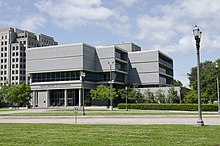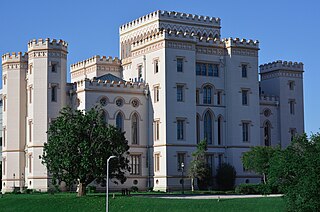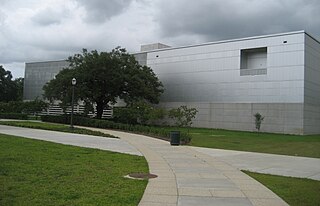
The State Library of Louisiana is Louisiana's state library agency, located in Baton Rouge. [1]

The State Library of Louisiana is Louisiana's state library agency, located in Baton Rouge. [1]
The current state library was not the first. The Louisiana State Library was created in 1838. It was originally located in New Orleans, which was the state capital at the time. In 1849 the capital was moved to Baton Rouge, and the library also moved. [2] During the Civil War the library was moved back to New Orleans to protect the collection. Only part of the collection was taken, and many of the materials that remained behind were lost or destroyed. [2]
The library was negatively affected by the Civil War due to decreased funds. The lack of funding lasted long after the war had ended and greatly impaired development of the collection. [2] The library remained in New Orleans until 1904. After years of neglect, the library was closed in 1911. The Law Library Society, which later became the Louisiana Law Library, added what remained of the collection to its own. [2]
In 1920, the Louisiana Legislature created the Louisiana Library Commission, a forerunner of the State Library of Louisiana. In 1925, the Commission joined with the philanthropic Carnegie Corporation to create a network of libraries across the state under the direction of Essae Martha Culver. [3] [4] The State Library of Louisiana opened on November 1, 1925, in Baton Rouge. [5] The League of Library Commissions was searching for a rural state in need of a book service but without any funds to begin operation on their own. [6] The league chose Louisiana to receive $50,000 from the Carnegie Corporation which was made available for a three-year demonstration period. In the beginning the state did not provide any additional financial assistance for the library. However, after the first year Louisiana appropriated $2,500 in aid. Yearly library appropriations by the state legislature have increased steadily over time. [6]
The first service available in 1925 was book lending by mail. In the first year three hundred requests were received for the service. [6]
From 1925 until 1932, the library was located in the Old State Capitol, in what was then called the old Adjutant General's Office. With other governmental departments, the library moved to the new capitol in 1932, to offices on the 18th floor. In 1940, the library was moved to North 3rd Street in the building which had been vacated by the Hill Memorial Library after Louisiana State University removed to a new campus south of town in 1926. [5]
In 1925 there were only five free public libraries in the state which served 600,000 people. [6] By 1950 there were 35 public libraries which served 2,225,000 people. [7]
In June 1954 the state legislature passed a bond issue which included $2 million for a new state library building. The old Hill Memorial Library lacked the space needed for collections and demonstrations. After months of debate about where the site for the new library should be, it was decided to demolish the old building and construct a new library at the same location. The new building officially opened in November, 1958. [7]
The Department for the Blind and Physically Handicapped, which had been run by the New Orleans Public Library since 1932, was taken over by the State Library in 1958 as the new building had a specially designed location for it. [7]

Baton Rouge is a city in and the capital of and the oldest city in the U.S. state of Louisiana. Located on the eastern bank of the Mississippi River, it is the parish seat of East Baton Rouge Parish, Louisiana's most populous parish. Since 2020, it has been the second-largest city in Louisiana after New Orleans; Baton Rouge is the 18th-most-populous state capital. According to the 2020 United States census, the city-proper had a population of 227,470; its consolidated population was 456,781 in 2020. The city is the center of the Greater Baton Rouge area—Louisiana's second-largest metropolitan area—with a population of 870,569 as of 2020, up from 802,484 in 2010. Baton Rouge is the fourth most populous city proper in the Deep South region of the southeastern United States.

Concordia Parish borders the Mississippi River in eastern central Louisiana. As of the 2020 census, the population was 18,687. The parish seat is Vidalia. The parish was formed in 1807.

Baker is a city in the U.S. state of Louisiana, in East Baton Rouge Parish. It is part of the Baton Rouge metropolitan statistical area, and had a population of 12,455 at the 2020 census, down from 13,895 at the 2010 U.S. census.

Louisiana State University is a public land-grant research university in Baton Rouge, Louisiana. The university was founded in 1860 near Pineville, Louisiana, under the name Louisiana State Seminary of Learning & Military Academy. The current LSU main campus was dedicated in 1926, consists of more than 250 buildings constructed in the style of Italian Renaissance architect Andrea Palladio, and the main campus historic district occupies a 650-acre (260 ha) plateau on the banks of the Mississippi River.
Port Hudson is an unincorporated community in East Baton Rouge Parish, Louisiana, United States. Located about 20 miles (32 km) northwest of Baton Rouge, it is known primarily as the location of an American Civil War battle, the siege of Port Hudson, in 1863.

Southern University and A&M College is a public historically black land-grant university in Baton Rouge, Louisiana. It is the largest historically black college or university (HBCU) in Louisiana, a member-school of the Thurgood Marshall College Fund, and the flagship institution of the Southern University System. Its campus encompasses 512 acres, with an agricultural experimental station on an additional 372-acre site, five miles north of the main campus on Scott's Bluff overlooking the Mississippi River in the northern section of Baton Rouge.

The Republic of West Florida, officially the State of Florida, was a short-lived republic in the western region of Spanish West Florida for just over 2+1⁄2 months during 1810. It was annexed and occupied by the United States later in 1810; it subsequently became part of Eastern Louisiana.

The Louisiana State Capitol is the seat of government for the U.S. state of Louisiana and is located in downtown Baton Rouge. The capitol houses the chambers for the Louisiana State Legislature, made up of the House of Representatives and the Senate, as well as the office of the Governor of Louisiana. At 450 feet (137 m) tall and with 34 stories, it is the tallest skyscraper in Baton Rouge, the seventh tallest building in Louisiana, and tallest capitol in the United States. It is located on a 27-acre (110,000 m2) tract, which includes the capitol gardens. The Louisiana State Capitol is often thought of as "Huey Long's monument" due to the influence of the former Governor and U.S. Senator in getting the capitol built. The building's construction was completed in 1931. It was listed on the National Register of Historic Places in 1978 and was designated a National Historic Landmark in 1982.

The Old Louisiana State Capitol, also known as the State House, is a historic government building, and now a museum, at 100 North Boulevard in Baton Rouge, Louisiana, U.S.A. It housed the Louisiana State Legislature from the mid-19th century until the current capitol tower building was constructed from 1929-32.

The foundation of Baton Rouge, Louisiana, dates to 1721, at the site of a bâton rouge or "red stick" Muscogee boundary marker. It became the state capital of Louisiana in 1849.

The Capitol Park Museum is a branch of the Louisiana State Museum located at 660 N. 4th Street, Baton Rouge, Louisiana.
John Hill of Homestead Plantation was a wealthy industrialist, sugar planter, philanthropist, and benefactor of Louisiana State University.
The following is a timeline of the history of the city of Baton Rouge, Louisiana, USA.

Alma Dawson is an American scholar of librarianship. She retired as Russell B. Long Professor at the School of Library & Information Science, Louisiana State University in 2014 and was awarded Emeritus status in 2015. In 2019 Dr. Dawson was honored with the Essae Martha Culver Distinguished Service Award from the Louisiana Library Association which honors a librarian whose professional service and achievements, whose leadership in Louisiana association work, and whose lifetime accomplishments in a field of librarianship within the state merit recognition of particular value to Louisiana librarianship.

Essae Martha Culver was an American librarian, the first state librarian of Louisiana and president of the American Library Association.
Scotlandville is a community in northern Baton Rouge, Louisiana. It was originally a small, independent rural community that developed along the Mississippi river in northern East Baton Rouge Parish. Only one Black family lived in the village in 1914 when Southern University and A&M College was relocated to this community. Originally based in New Orleans, the university was designated in 1890 as the state's land grant college for Black people, when education was segregated in the state.

William Arceneaux is a Louisiana higher education official, an American professor, historian, writer, and Louisiana native. Arceneaux is President of the Council for the Development of French in Louisiana (CODOFIL), having been elected in January of 2011.
Mary Mims was born in Minden, Louisiana. She was a community organizer, teacher, educator, humanitarian, lecturer, and a pioneering sociologist. She was the founder of the “community organization movement” in cooperative extension. She was an extension services specialist in community organizing and worked for Louisiana State University. She was a state community worker for Louisiana.

The Louisiana Library Association (LLA) is a professional organization for Louisiana's librarians and library workers. It is headquartered in Baton Rouge, Louisiana. The LLA publishes The LLA Bulletin (est. 1937) and Louisiana Libraries magazine.